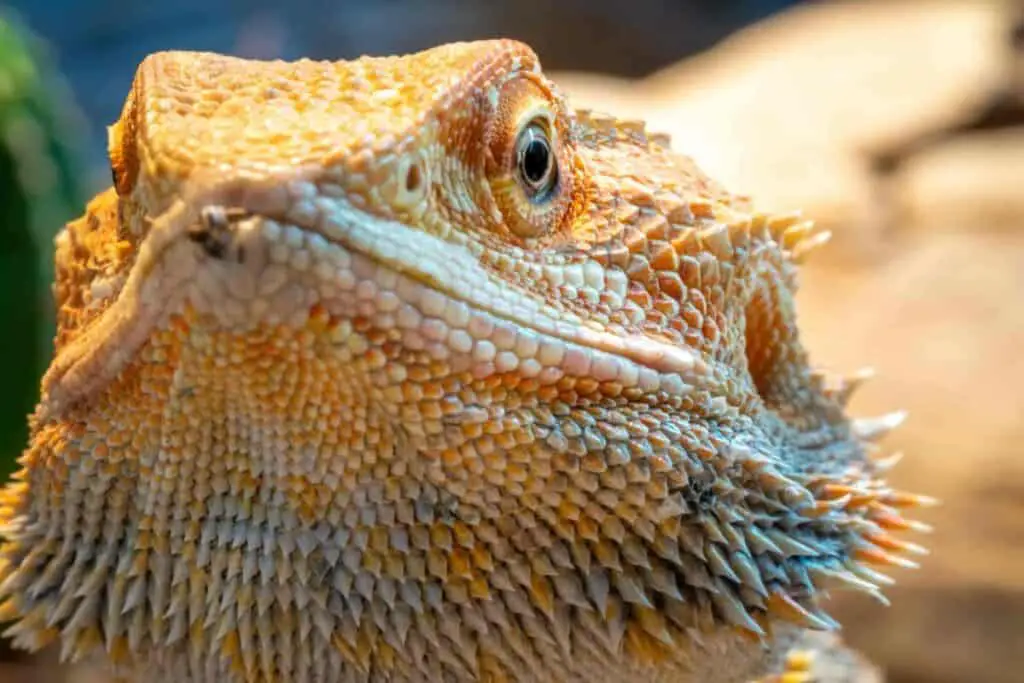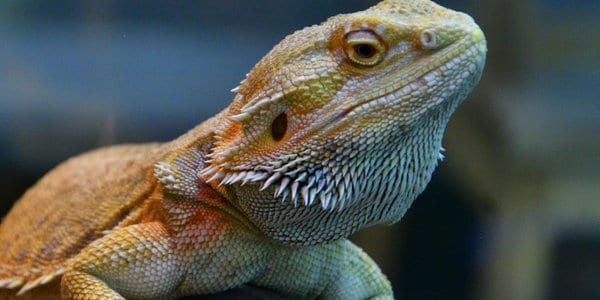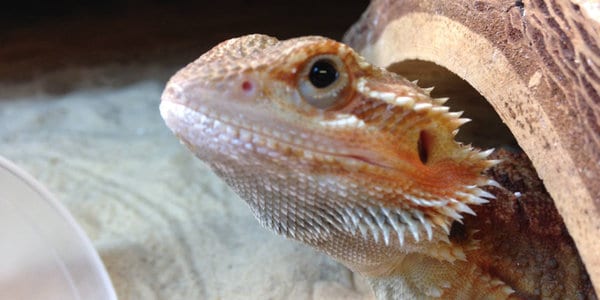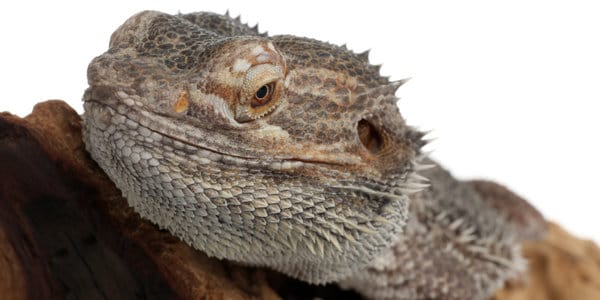The holes on a beardies head are its ears. Yes, that is the organ through which your pet recognizes your voice. These holes are located between the mouth corner and the eye on each side of the bearded dragon head. Their hearing ability is so good that they can hear tiny animals such as worms crawling in their habitat, which comes in handy during feeding.
Unlike mammals with prominent ears, those of a bearded dragon look like holes. These lizards lack an external ear that collects sound. Despite this, these lizards have a remarkable hearing mechanism that aids their survival in the wild.
Let us have an in-depth look at a bearded dragon’s hearing mechanism and the function of the other holes on this lizard.
A Bearded Dragon’s Hearing Mechanism
As earlier mentioned, the holes on a bearded dragon’s head are its ears, and they are central to the pet’s hearing mechanism. Let’s have a deeper look at a bearded dragon’s ear structure.
External Ear
A bearded dragon lacks the external ear. It is no wonder that most people get curious, does a bearded dragon have ears? Do bearded dragons hear? In most animals, especially mammals, the outer ear is often associated with the hearing mechanism. It helps the animals collect sound waves and directs them to the inner ear.
Even without the external ear, a bearded dragon can hear. The absence of this part does not affect their hearing, and these reptiles can, in fact, hear pretty well.
Instead of the external ears, bearded dragons have cavities on both sides of the head. The simple cavities are covered with a tympanic membrane connecting with the inner ear.
Inner Ear
A beardie’s internal ear is fully developed and resembles that of most animals. The tympanic membrane catches sound vibrations and transmits them to the other parts of the inner ear.
Stapes, also known as the stirrup, is a tiny bone which is another part of the ear responsible for picking vibrations from the tympanic membrane and transmitting them to the cochlear duct.
A cochlear duct is filled with fluid and has small hair-like pieces that relay the signals to the brain of the bearded dragon. It is here that these signals are interpreted through the beardie’s auditory nerve.
Besides helping the beardie to hear well, the inner ear, as with most animals, also helps the lizard maintain body balance.

The Importance Of A Bearded Dragon’s Ears
Now that we know the mechanism of a beardie’s ear and its general structure, is this organ really important? Do bearded dragons need the ears? The answer is yes; bearded dragons need ears for several reasons, and below are the main ones.
1. To Escape Predators
Bearded dragons have many predators, such as snakes, foxes, birds of prey, goannas, and dingoes. In order to survive in the wild, beardies need a mechanism for escaping their predators, and hearing is one way they manage to do so.
Besides hearing sounds, beardies can also detect a predator’s movement through ground vibrations.
2. To Catch Prey
Just like how bearded dragons have predators, they are also predators to other animals. These omnivorous reptiles hunt and feed on insects and bugs.
Hearing helps these bearded dragons manage to catch their prey which can be quite a task. It takes them a lot of patience and tact and a strong sense of hearing.
Pet bearded dragons do not hunt, but it still helps to have a strong sense of hearing. When fed with live worms that hide in the enclosure, they can also use this sense to hunt in the tank.
3. To Maintain Balance
A bearded dragon’s inner ear helps them achieve body balance. The inner ear has organs, including the semicircular canals, that help achieve this. It is not a unique function to bearded dragons but applies to most animals as well.
The proper balance enables bearded dragons to climb and live in fairly high places from which they would otherwise fall off. Balance is vital even in captivity because it helps avoid fall-related injuries, which can be costly and time-consuming to treat.
Signs of Ear Infection In Bearded Dragons
Bearded dragons are prone to ear infections, which can significantly affect their quality of life. Below are signs that can help you detect ear infections in your pet beardie.
- Ear discharge
- Swollen tympanic membrane
- Loss of balance
- Tilting head
- Hearing loss
- Imbalance when walking
If you notice any of these symptoms, immediately contact an exotic vet. The professional will examine the signs to diagnose the underlying cause.
Depending on the extent of the ear infection, the vet may recommend antibiotics and care measures to implement and prevent recurring ear infections in the future.
Effective Bearded Dragon Ear Care Tips
It is evident that hearing is quite vital for a bearded dragon. For instance, infections in its internal ear can affect its balance. Thus, it is vital to take care of your beardie’s ears to ensure a great overall quality of life. Here are tips on taking care of your bearded dragon’s ears.
1. Proper Diet
Over and over, food has been likened to medicine, and there is a good reason for this. Providing your pet with a proper diet ensures that the growth and development of its organs, including ears, is appropriate.
In addition, a good diet promotes the lizard’s immune system, thereby helping it fight illnesses and infections.
Bearded dragons are omnivorous and require varying proportions of plant-based and animal-based foods at different stages of their lives.
Knowing the right amounts of food to feed the beardie at various stages of its life ensures that you give the pet a proper diet that meets its current protein, mineral, fats, and vitamin needs.
Supplementation also plays a part in giving the lizard a proper diet. Calcium is one of the vital supplements you should give the pet.
However, do not give the pet too much calcium as it might lead to hypercalcemia, which affects the beardie’s health.

2. Provide Ideal Temperature and Humidity
The ideal temperature of different parts of a bearded dragon’s tank varies. For instance, that of the basking area is higher than that of the cooler part. In addition, night temperatures are lower than daytime temperatures. When the temperature is higher or below the suitable range for the beardie, its hearing will be affected.
Humidity also affects the functioning of a bearded dragon’s ear. Ensure that the enclosure humidity remains between 30 and 40% to avoid ear infections.
3. Provide A Suitable Shedding Environment
From time to time, bearded dragons shed their skin. While you shouldn’t peel the shedding skin, there are measures you can take in the tank to ensure that you provide a conducive natural habitat for shedding. Some of them include giving rough substrates against which your beardie can rub off the shedding skin.
Poor shedding leads to skin build-up that can contribute to ear infections.
Why Does My Bearded Dragon Have A Hole In His Head?
The hole that appears like a dot in a bearded dragon’s head is its third eye. It is found between the other two eyes, and although it doesn’t look like the other eyes, it is an actual eye. Other names that refer to the reptile’s third eye include the solar, pineal, or parietal eye.
A beardie’s third eye has a lens and a retina. However, it lacks an iris, so it appears different from the others. It is also smaller and comes with a scale covering it, which is why if you are not careful, you might miss seeing it.
The third eye helps beardies helps them;
- Sense items such as predators from above
- Regulate biological processes such as knowing when to sleep, wake up, etc.
- Knowing directions
It is essential to take care of this vital part of the beardie, especially because of the immense benefits it has for the lizard.
Ensure to turn off the lights in its habitat at night to avoid interrupting the third eye’s biological processes regulation process.
You can get automatic lights to help with this. Such lamps are automated, and they automatically turn off when it’s time.
In addition, avoid creating shadows over this eye by ensuring that you do not approach the pet from above. Another way of taking care of the bearded dragon’s third eye is sticking to natural light and avoiding artificial ones.

What Are The 2 Holes On The Side Of A Bearded Dragon?
The two holes on the bearded dragon’s side are femoral pores. These are visible from the lizard’s underside close to the anal opening on each thing. They resemble small circles or dots.
In male bearded dragons, femoral holes produce pheromones for making territory. It also helps sends signals to the female beardies during the mating season. They are also significantly bigger in males and keep growing with age.
On the other hand, femoral holes are tiny in females and hardly grown big, which is one of the ways you can distinguish the sexes.
These holes need effective care, as with all other parts of a bearded dragon. When the pores get clogged, the pet will get blackheads. Femoral pores can block due to the beardie not rubbing its legs on rough surfaces enough.
As such, there tends to be a build-up. In addition, clogging might result from the keratin or lipid secretions hardening faster before the bearded dragon can rub them off.
Ensure to provide your pet beardie with rough enough surfaces for rubbing off the pores to clear the femoral pores, give it frequent baths, enough Vitamin A, and ideal habitat humidity. These will play a vital role in ensuring that your pet-bearded dragon does not suffer from clogged femoral pores.
Why Do Lizards Have Holes In Their Heads?
The holes in a bearded dragon’s head are its ears. They aid the pet with its hearing mechanism. As such, a bearded dragon can recognize its owners, note the presence of worms in the habitat, etc. In the wild, hearing helps beardies with hunting and also escaping predators.
The other hole-like part of a bearded dragon’s head is its third eye. The eye’s appearance is different from normal eyes, but it is equally vital to the lizard’s day-to-day functioning.

Frequently Asked Questions
Do Bearded Dragons Have Ears?
Yes, bearded dragons have ears. They lack the external ear structure, but they can hear through hole-like structures on their head. A sheer-like thin membrane recessed across the opening known as the tympanic membrane covers these ear holes. However, their inner ear structure is well developed, enabling the pet to hear well.
Can My Bearded Dragon Hear Me?
Yes, your bearded dragon can hear you well. It can recognize your voice and even its name. Thus, you should often speak to your beardie and call it by its name to strengthen your bond. Because of the excellent sense of hearing, you can train the pet to approach you when you call it.
It might take time, but it’s all worth it. Some pet beardies will take longer before starting to respond to your voice; thus, you should not compare the progress of one pet beardie to the other.
How Good Is A Bearded Dragon Hearing?
Bearded dragons can hear 500 – 4,000 Hz, which is impressive for the reptile. It is enough to help them the sound of insects and bugs around them. In addition, the auditory ability is enough to detect the sound of most of their predators.
Do Bearded dragons Have Middle Ear?
Yes, bearded dragons have middle ear which is covered by a tympanic membrane.
Conclusion
The holes on a bearded dragon’s head are its ears. Although the lizard lacks an external ear, its sense of hearing is still impressive. They have a well-developed internal ear that detects even minor sounds. The other hole is a third eye which aids the pet’s daily functioning and helps it stay out of danger.
A good sense of hearing is vital for bearded dragons because it helps them to avoid predators and also helps them catch prey, especially in the wild. Because of the good sense of hearing, beardies can hear and recognize their owner’s voice.
So go ahead and call your pet by its name. With time, your beardie will respond by approaching you in the tank when they hear you.